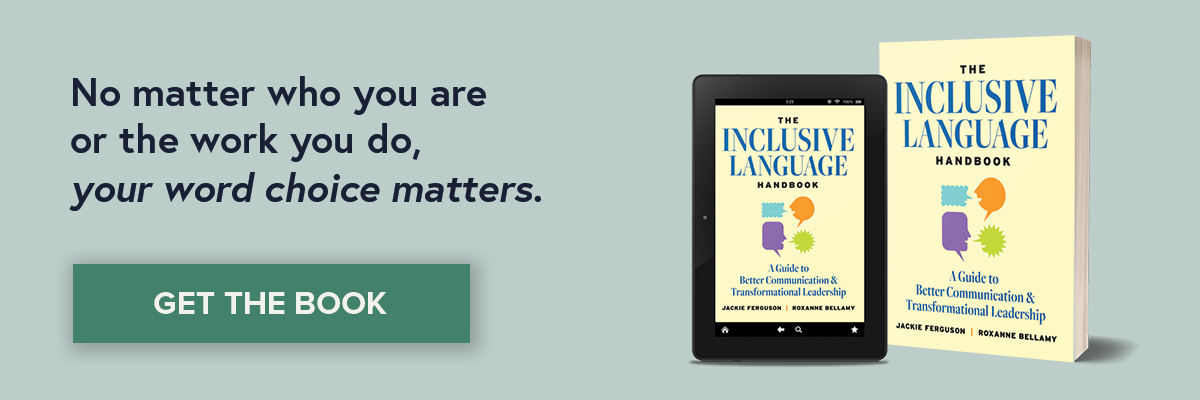Inclusive language matters in all manner of business communications, from the ways we create workplace culture through interpersonal interaction with colleagues to the marketing content that connects us with stakeholders and communicates who we are. While writing The Inclusive Language Handbook with my mentor and colleague Jackie Ferguson, one of the aspects of inclusive language we explored was the question of what it means to be inclusive with your word choice in a particular profession, since inclusive language can mean something slightly different when applied to technology, retail, manufacturing, or – as will be my focus here – the healthcare industry.
In healthcare specifically, inclusive language has the tremendous potential to reduce inequities, improve outcomes, and create safer, healthier lives for everyone. That’s why better communication –by which I mean more respectful, affirming, accurate, precise, and relevant communication – is a core recommendation for healthcare professionals from both the CDC and the Agency for Healthcare Research and Quality.
Why inclusive language matters in healthcare
By learning best practices for inclusive language, healthcare professionals can eliminate bias, promote impartiality, reduce stigmas, and above all else, be helpful to all people. As Dr. Jack Leonard Jr. writes in “Advancing Health Equity, Eliminating Health Disparities, and Improving Population Health,” “achieving health equity requires valuing everyone equally with focused and ongoing societal efforts to address avoidable inequalities, historical and contemporary injustices, and the elimination of health and health care disparities.” Inclusive language is part of that solution.
Knowing the best terms for every individual’s unique background, experiences, and identity communicates that every one of those people is valuable and deserves great care. Inclusive language can be especially impactful in improving health disparities for people from marginalized communities and cultures. Namely, in America that means people who are part of the LGBTQ+ community (especially LGBTQ+ youth), people with diverse racial and ethnic backgrounds (especially Black people), individuals from lower socioeconomic origins, and people with lower education levels.
Of course, healthcare organizations today face a unique set of challenges, especially in the wake of the COVID-19 pandemic. One notable phenomenon is the shifting interpersonal dynamics of the practitioner-client relationship. Healthcare professionals around the world are now facing folks who openly distrust them, or at least question their qualifications, intention, and thinking.
In light of these changing dynamics – plus shifting demographics as the world grows more diverse – inclusive communication is critical to the delivery of quality care. Developing high-trust, empathetic relationships leads to open and honest communication, which in turn leads to more effective treatment and better outcomes overall.
To feel safe and capable, people need healthcare environments that are free from stigma, bias, and discrimination. In that way, inclusive language plays a key role in helping to make healthcare settings physically, emotionally and psychologically safe places where people can do well, consistently. When we feel safe, we can better advocate for ourselves and others.
Word choices you can make to increase inclusion
To start, let’s talk about removing the word “patient.” Although this term might be somewhat acceptable when used in an abstract sense, healthcare professionals should avoid it when discussing the real people they’re caring for. Using the word patient can have negative connotations and inadvertently dehumanize the person who is using your healthcare services. I know that sounds like a bold statement, especially since this word is so common in our language, so let me take a minute to explain.
Not surprisingly, much of the lexicon of medicine is rooted in ancient languages like Greek and Latin. The term patient is no exception. It comes from the Latin verb pati, meaning “to suffer.” Our continued, ubiquitous use of this word implies that the person engaging in care is – and should be – a passive recipient. What we picture when we think about a patient is a submissive, uncomplaining sufferer who exists as part of an unequal relationship to their well-informed, expert rescuer: their assigned healthcare professionals.
As the famed Baroness Julia Neuberger points out in “Do we need a new word for patients?,” the word patient implies passivity and that the job of any person using a healthcare service is to do what they are told “then wait patiently to recover. The healthcare professional is the healer, while the recipient of healthcare services is the healed, and does not need to take a part in any decision making or in any thinking about alternatives.”
Using the term patient centers the conversation on that person’s current condition, injury, ailment, or illness, rather than focusing on their whole self. In the same way, more inclusive, more respectful, and unbiased language allows all people to think of themselves as full, complete humans, not be reduced to their current medical state and its label.
What should you say instead? When you can, refer to each person by their first and last name. When you can’t – or don’t want to – I suggest using person-centered grammatical constructions. That is, phrases that include the word person or people. For instance, rather than referring to a person as a “cancer patient,” say “a person who has been diagnosed with cancer” or “a person with a cancer diagnosis.” When necessary to maintain confidentiality, consider simply “person” or “client” instead. For instance, you might say “the client in room 211” or “the people in the waiting room.”
When you’re unsure what to say, keep the words person and people in the center of mind. For instance, not everyone who is pregnant will identify with the term “mother.” Thus, you should say “the pregnant person” instead. Other inclusive replacements include “people with a prostate gland” and “people with a cervix,” which acknowledge nonbinary and transgender people who may have reproductive parts that do not align with their gender identity.
Inclusive language tools for your toolbox
As with any job, implementing inclusive language – and getting it right over time – requires the right tools and training. The good news is: there are many ways to begin advancing your organizational intelligence with regard to inclusion. One first step is unconscious bias training so that you and your teammates can understand and mitigate any preconceptions you may have at an individual or team level with regard to ethnicity, cultural background, race, sexuality, physicality, religion, and many more dimensions of diversity.
And of course, The Inclusive Language Handbook: A Guide to Better Communication and Transformational Leadership is a foundational resource for all professionals. In it, you’ll find the six core guidelines for inclusive language with additional recommendations for healthcare practitioners and for respectful word choice outside the workplace as well.
With an academic background in literature and linguistics, Roxanne Bellamy, CDE loves exploring the intersection between the words we choose and the way we see the world. She is co-author of The Inclusive Language Handbook: A Guide to Better Communication and Transformational Leadership.







